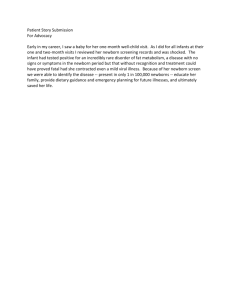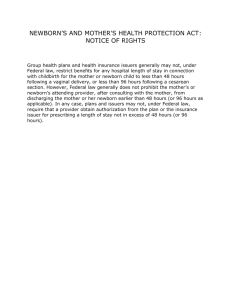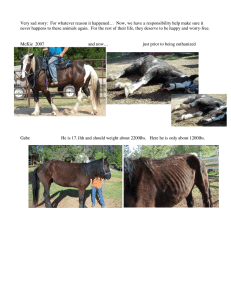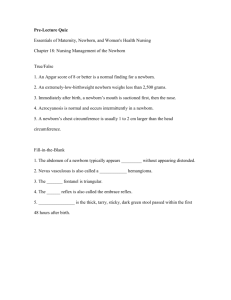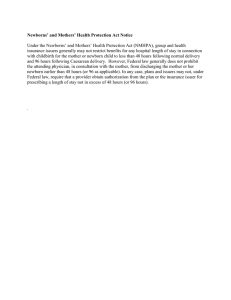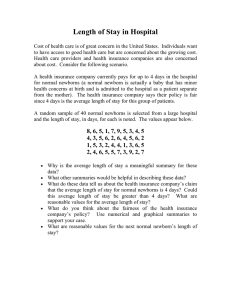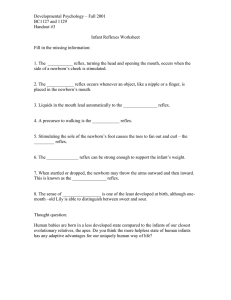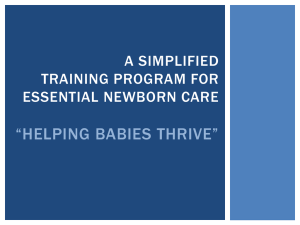Pediatric Health Assessment: Child Preparation
advertisement
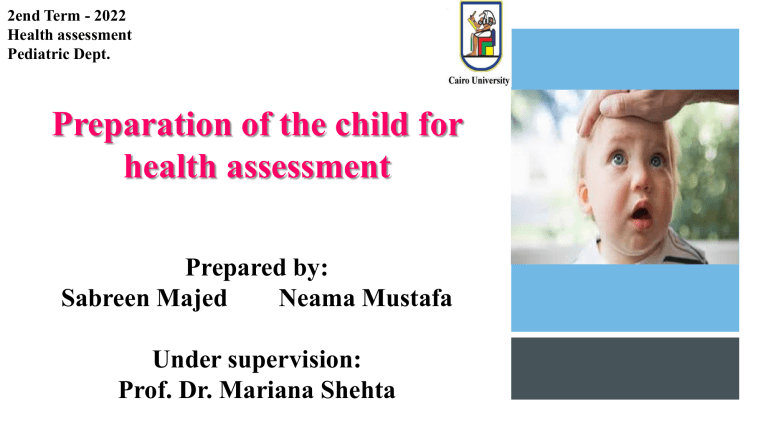
2end Term - 2022 Health assessment Pediatric Dept. Preparation of the child for health assessment Prepared by: Sabreen Majed Neama Mustafa Under supervision: Prof. Dr. Mariana Shehta OBJECTIVES At the end of this presentation candidate will be able to Identify to key terms related to health Explain Purpose of the Health Appraisal Discuss Components of the Health Appraisal Discuss physical examination of infant Recognize Health Instruction and Counseling OUTLINE Introduction Definition of health, health assessment and health appraisal Purpose of the Health Appraisal Components of the Health Appraisal.. Detailed physical examination INTRODUCTION The child’s primary health care provider should perform the health appraisal, including the physical examination component. Knowledge of the child’s family and home, previous illnesses, immunization status, and other background factors assist in evaluating the total health status of the child. The primary health care provider is also in a position to institute, without delay, any necessary therapeutic measures Key Terms Health Is a state of complete physical, mental, and social well-being and not merely the absence of disease. The World Health Organization Health assessment; is a plan of care that identifies the specific needs will be addressed by health care system or skilled nursing facility. Health assessment is evaluation of the health status by performing a physical exam after taking a health history. It is done to detect diseases early. . Health appraisal or health risk assessment Is a series of procedures to assess or determine the health status of children. Is a tool that allows health providers to gather information about an individuals physical health and lifestyle. The health status of the child is determined through the use of teacher’s observation, screening test, health histories, and medical, dental, and psychological evaluations. PURPOSE OF THE HEALTH APPRAISAL 1- Make an appropriate appraisal of the child’s current health status . 2- Discover any health problems which require further investigation and treatment, if such is indicated. 3- Provide an opportunity to counsel the child and the parents. 4. Provide a valuable and positive health experience for the child. COMPONENTS OF THE HEALTH APPRAISAL 1) Health History 2) Screening procedures 3) Observations of behavior and performance 4) Physical examination 1. Health history School entrance health history Interval health history Update the health & medical history. done annually every specific period as interval health history to players Past history Family history Current status Comprehensive medical/develop mental, psychological history In depth history include both two previous types Epidemic health history. To plan for treatment/ma nagement immediately or in the near future Past history Others Prenatal such as prenatal exposure to illicit drugs, toxins, or infections, maternal diabetes, acute maternal illness, trauma, radiation exposure, prenatal care, and fetal movements Perinatal history; Immunization Childhood illness as GA, delivery type, birth weight, For developing children's immune systems. - Significant accident/injury. - Previous hospitalization - Allergies - Medications used. - Surgery Family history Age and general health of parents and siblings Education level of parents History of family disease (inherited disease such as sickle cell anemia and phenylketonuria (PKU) Physical environment. Social history: including tobacco, alcohol, and recreational drug use. Cultural factors: including primary language and educational level. Current history Dental Family medical problems Child’s health problems/allergies Behavior Psychosocial factors 2. SCREENING PROCEDURES are supplemental evaluations of: a. Vision b. Hearing c. Scoliosis d. Blood pressure e. Height and weight f. Urine specimen for glucose and protein g. Any other screenings locally determined 3. Observations of behavior and performance Observations (both formal and informal) of behaviors indicative of: altered interpersonal relationships underlying health problems impairment of school function acute illness 4. PHYSICAL EXAMINATION 1) General examination. 8) Neck 2) General look. 9) Chest 3) Anthropometric measurement. 10) Abdomen 4) Vital signs 11) Genitalia 5) Skin 12) Extremities & Back 6) Head 13) Neurologic status 7) Face PHYSICAL EXAMINATION PROCEDURE Chest. cardiovascular system. Abdomen. Neurological system. PHYSICAL EXAMINATION 1) General examination “ABCDEF” Appearance Built (body building) Consciousness (by Glasgow score) Decubitus (impairment in skin layers) Environment Faces 2) General look 3) Anthropometric / Growth measurements Weight: (2.500 – 3.500gm) measure daily Length (<2 yrs.)/ Height (>2yrs.): measure weekly, (44-55cm) from head to soles of feet in supine position Head circumference: (33-35cm) or ¾ length, measure weekly. Chest Circumference: measure weekly. less than head circumference 2cm, while at 12-14 months become both equal, and at 24 months chest > head circumference. Abdominal Circumference: before feeding, not routinely measure unless there is abdominal distension. HEAD, CHEST, AND ABDOMINAL CIRCUMFERENCE 4) Vital signes Respiratory Rate: normal (120-160), symmetric & slightly irreqular. For 1min. Pulse Rate (40-60 bpm) on Lt 4th intercostal space upper nipple. for 1 min. Temperature (36.4- 37.4c) axillary for 5-8min Blood Pressure: systolic (50-75mmhg), diastolic (30-45mmhg) Blood pressure is not routinely assessed in a normal newborn unless the baby’s clinical condition warrants it. Pain Normal rate according to child age. 5) Skin Observe the overall appearance of the skin, including color, texture, turgor, and integrity. The newborn’s skin should be smooth and flexible, and the color should be consistent with genetic background. Skin Condition and Color: Check skin turgor by pinching a small area of skin over the chest or abdomen and note how quickly it returns to its original position. In a well-hydrated newborn, the skin should return to its normal position immediately. Skin that remains “tented” after being pinched may indicate dehydration. A small amount of lanugo (fine downy hair) may be observed over the shoulders and on the sides of the face and upper back. Acrocyanosis: is blue/ red discoloration and coldness of fingers, hand, toes, feet. It may be seen in newborns during the first few weeks of life in response to exposure to cold. Acrocyanosis is normal and intermittent. Newborn Skin Variations • Skin lesions can be congenital or transient • Bruising may result from the use of devices such as a vacuum. • Petechiae may be the result of pressure on the skin during the birth process. • Forceps marks may be observed over the cheeks and ears. Common skin variations include vernix caseosa, stork bites or salmon patches, milia, Mongolian spots, erythema toxicum, harlequin sign, nevus flammeus, and nevus vasculosus Common skin variations. A. Stork bite. B. Milia. C. Mongolian spots. D. Erythema toxicum. E. Nevus flammeus (port-wine stain). F. Strawberry hemangioma. Vernix caseosa: is a thick white substance that protects the skin of the fetus. It is formed by secretions from the fetus’s oil glands and is found during the first 2 or 3 days after birth in body creases and the hair. It does not need to be removed because it will be absorbed into the skin. Stork bites or salmon patches: are superficial vascular areas found on the nape of the neck, on the eyelids, and between the eyes and upper lip. They are caused by a concentration of immature blood vessels and are most visible when the newborn is crying. They are considered a normal variant, and most fade and disappear completely within the first year. Milia: are multiple pearly-white or pale yellow unopened sebaceous glands frequently found on a newborn’s nose & chin, forehead, form from oil glands and disappear within 2 to 4 weeks. Epstein’s pearls: its Milia when occur mouth and gum. They occur in approximately 80% of newborns. As most lesions break spontaneously within the first few weeks. (El-Radhi, 2015). Mongolian spots: are benign blue or purple splotches that appear solitary on the lower back and buttocks of newborns, caused by a concentration of pigmented cells and usually disappear spontaneously within the first 4 years of life. (Silverberg, 2015) Erythema toxicum (newborn rash) is a benign, idiopathic, generalized, transient rash in face check & neck that occurs in up to 70% of all newborns during the first week of life. disappears in a few days. Harlequin sign refers to the dilation of blood vessels on only one side of the body, described as pale on the nondependent side and red on the opposite, dependent side. It results from immature autoregulation of blood flow and is commonly in LBW when there is a positional change. (Lomax, 2015). It is transient, lasting as long as 20 minutes, and no intervention is needed. Nevus flammeus: also called a port-wine stain, commonly appears on the newborn’s face, neck & head. It is a capillary angioma - It is flat, purple red skin lesion result of dilated capillaries. - Varity in size from a few millimeters to large, occasionally cover 1/2 the body surface. - not grow in area or size - permanent and will not fad. - Port-wine stains may be associated with structural malformations, bony or muscular overgrowth, and certain cancers. - Lasers and intense pulsed light have been used to remove larger lesions with some success. The optimal timing of treatment is before 1 year of age (Giese & Richter, 2015). Nevus vasculosus: also called a strawberry mark or strawberry hemangioma - is a benign capillary hemangioma in the dermal and subdermal layers. (El-Radhi, 2015) - It is raised, rough, dark red, and sharply demarcated - It is commonly found in the head region within a few weeks after birth - Can increase in size or number. - may be absent in the first few weeks of life, but they proliferate in the first few months of life. - Common in premature, VLBW (less than 1,500 g) - resolve by age 3 without any treatment. 6) Head Head size varies with age, gender, and ethnicity and has a general correlation with body size. Normal head is symmetric and round. As many as 90% of the congenital malformations present at birth are visible on the head and neck. (Pfister & Ramel, 2014). The newborn has two fontanels at the cranial bones: 1) The anterior fontanel; (closes by 18 to 24 months), diamond shape, measures 4 to 6 cm 2) The posterior; (closes by 6 to 12 weeks), is triangular, smaller than the anterior fontanel (usually fingertip size or 0.5 to 1cm). Palpate both fontanels, which should be soft, flat, and open. Then palpate the skull. It should feel somewhat smooth and fused, except at the area of the fontanels, over molding areas, and sutures. Variations in Head Size and Appearance include: 1) Molding is the elongated shaping of the fetal head to accommodate passage through the birth canal. It occurs with a vaginal birth from a vertex position in which elongation of the fetal head occurs with prominence of the occiput and overriding sagittal suture line. It typically resolves within a week after birth without intervention. 2) caput succedaneum describes localized edema/ swelling soft tissue on the scalp that occurs from the pressure of the birth process, after prolonged labor or delivered via vacuum. - Pitting edema and overlying Petechiae and ecchymosis are noted. - The swelling will gradually dissipate in about 3 days without any treatment. A1 and A2. Caput succedaneum involves the collection of serous fluid and often crosses the suture line. (A2.. From Chung, Visual diagnosis and treatment in pediatrics (2nd ed.). Philadelphia:LWW.) 3) Cephalohematoma is a localized collection of blood of the skull which is always confined by one cranial bone due to pressure on the head and disruption of the vessels during birth. - It occurs after prolonged labor and use of obstetric interventions such as low forceps or vacuum. - usually appears on the second or third day after birth and disappears within weeks or months. - Large Cephalohematoma can lead to increased bilirubin levels and subsequent jaundice (Hyperbilirubinemia). (Lomax, 2015) - The clinical features include a well-demarcated, often fluctuant swelling with no overlying skin discoloration. The swelling does not cross suture lines and is firmer to the touch than an edematous area. - Aspiration is not required for resolution and is likely to increase the risk of infection. B1 and B2. Cephalhematoma involves the collection of blood and does not cross the suture line. (Photos, except for (A2), from O’Doherty, N. (1979). Atlas of the newborn. Philadelphia: J B Lippincott,1979:136, and 1979:117, 143, with permission.) Common Abnormalities in Head or Fontanel Size that may indicate a problem include: 1. Microcephaly: a head circumference >2 standard deviations below average or < 10% of normal parameters for gestational age, caused by failure of brain development. Microcephaly production of neurons brain volume skull size. Children with severe microcephaly, defined as more than 3 standard deviations below the mean for age and sex, are more likely to have imaging abnormalities and more severe developmental impairments than those with milder microcephaly. About 40% of children with microcephaly also have epilepsy, 20% have cerebral palsy, 50% have intellectual disability, and 20% to 50% have ophthalmologic and hearing disorders (Boom, 2015a). It can be familial, with autosomal dominant or recessive inheritance, and it may be associated with infections (cytomegalovirus), rubella, toxoplasmosis, and syndromes such as trisomy 13, 18, or 21 and fetal alcohol syndrome. Genetic counseling and clinical management through carrier detection/prenatal diagnosis in families can help reduce the incidence of these disorders (Alcantara & O’Driscoll, 2014). 2. Macrocephaly a head circumference more than 90% of normal, typically related to hydrocephalus (Boom, 2015b). It is often familial (with autosomal dominant inheritance) and can be either an isolated anomaly or a manifestation of other anomalies, including hydrocephalus and skeletal disorders (achondroplasia). 3. Large fontanels: >6 cm in the anterior or >1cm posterior fontanel diameter. possibly associated with malnutrition, hydrocephaly, congenital hypothyroidism, trisomies 13, 18, & 21, and various bone disorders such as Osteogenesis imperfecta. 4. Small or closed fontanels: smaller than normal anterior and posterior diameters or fontanels that are closed at birth. Craniosynostosis and abnormal brain development are associated with a small fontanel or early fontanel closure associated with microcephaly (Sheth, Ranalli, & Aldana, 2014). 7) Face The face should have full cheeks and should be symmetric when the baby is resting and crying. If forceps were used during birth, the newborn may have bruising and reddened areas over both cheeks and parietal bones secondary to the pressure of the forceps blades. Also facial nerve paralysis caused by trauma from the use of forceps. Paralysis is usually apparent on the first or second day of life. Clinical features: - asymmetry of the face with an inability to close the eye - move the lips on the affected side, - difficulty making a seal around the nipple - milk drools from the paralyzed side of the mouth. Most facial nerve palsies resolve spontaneously within days In face should assessment involve: A) Nose: Inspect the nose for size, symmetry, position, and lesions. The newborn’s nose is small and narrow. The nose should have a midline placement, patent nares, and an intact septum. Nostrils; equal size and patent (suctioned by a bulb syringe to remove mucus from the mouth & nose, with a head down & turn to side for facilitates drainage. Care is given under a radiant heater) Nasal mucosa; A slight mucous discharge may be present, but there should be no actual drainage. The newborn is a preferential nose breather and will use sneezing to clear the nose if needed. The newborn can smell after the nasal passages are cleared of amniotic fluid and mucus (Clark-Gambelunghe & Clark, 2015). B) Mouth: Inspect the newborn’s mouth, lips, and interior structures. The lips should be intact with symmetric movement, in the midline, no any lesions, pink color, moisture, and cracking. The lips should encircle the examiner’s finger to form a vacuum. Variations of the lip include, cleft upper lip (separation extending up to the nose) or thin upper lip associated with fetal alcohol syndrome. Assess the oral cavity for alignment of the mandible, intact soft and hard palate, sucking pads inside the cheeks, a midline uvula, a free-moving tongue, and working gag, swallow, and sucking reflexes. The mucous membranes lining the oral cavity should be pink and moist, with minimal saliva present. Throat, Tonsils & Posterior pharyngeal wall. Normal variations in oral cavity might include: - Epstein’s pearls (small, white epidermal cysts on the gums and hard palate that disappear in weeks). - Erupted natal teeth Natal teeth can be present at birth and are usually considered benign. No treatment is needed if they don’t interfere with feeding. may need to be removed to prevent aspiration. - Thrush (white plaque inside the mouth caused by exposure to Candida albicans during birth), which cannot be wiped away with a cotton-tipped applicator. C) Eye The normal eyes should be clear and symmetrically placed. Inspect the external eye structures including the eyelids, lashes, conjunctiva, sclera, iris, cornea and pupils (position, color, size, reflex and movement). Eyelids: lid edema with sterile discharge resolves within 48 hours without treatment. Conjunctiva: subconjunctival hemorrhage due to pressure during birth. Chemical conjunctivitis commonly occurs within 24 hours of instillation of eye prophylaxis after birth. Ophthalmia neonatorum is a hyperacute purulent conjunctivitis occurring during the first 10 days of life. Because during birth the baby contact with vaginal discharge of the mother infected with gonorrhea and chlamydia. Most often both eyelids become swollen and red with purulent discharge. Infant & newborn birth must receive an installation of a prophylactic agent in their eyes within 1-2 of birth to prevent Ophthalmia neonatorum, which cause neonatal blindness. (CDC, 2015a) Pupils: should be equal, round, and reactive to light bilaterally ( pupillary reflex). Test the blink reflex by bringing an object close to the eye, the newborn should respond quickly by blinking. Ocular movement: Movement may be uncoordinated during the first few weeks of life. Many newborns have transient strabismus (deviation or wandering of eyes independently). searching Nystagmus (involuntary repetitive eye movement), which is caused by immature muscular control. These are normal for the first 3 to 6 months of age. A red reflex (luminous red appearance seen on the retina) should be seen bilaterally on retinoscopy. The red reflex normally shows no dullness or irregularities. Assess the newborn’s gaze: he or she should be able to track objects to the midline. D) Ears Inspect the ears for External ear (size, shape, skin condition, placement, amount of cartilage) and External auditory canal EAC (patency of the auditory canal). The ears should be soft and pliable and recoil quickly and easily when folded and released. aligned with the outer canthi of the eyes. Low-set ears and abnormally shaped ears are characteristic of many syndromes and genetic abnormalities, such as trisomy 13 or 18, and internal organ abnormalities involving the renal system. Findings of sinuses or pre-auricular skin tags should prompt further evaluation for possible renal abnormalities since both systems develop at the same time. An Otoscopic examination is not typically done because the newborn’s ear canals are filled with amniotic fluid and vernix caseosa, which make difficult visualization of the tympanic membrane. Newborn hearing screening: Screening at birth o Hearing loss is the most common birth defect in the One in 1,000 newborns are profoundly deaf. (March of Dimes, 2015a). o Delays in identification and intervention may affect the child’s cognitive, verbal, behavioral, and emotional development. o Causes of hearing loss can be conductive, sensorineural, or central. o Risk factors for congenital hearing loss include cytomegalovirus infection and preterm birth a stay in NICU. o To assess hearing ability by observe the newborn’s response to noises and conversations. typically they turns toward these noises and startles with loud ones. o Treatments include cochlear implantation, hearing augmentation, and follow-up by an audiologist, otolaryngologist, pediatrician, geneticist, and deaf education specialist (Nikolopoulos, 2015) 8) NECK Inspect the newborn’s neck for movement and ability to support the head. The newborn’s neck will appear almost nonexistent because it is so short. Creases are usually noted. The neck should move freely in all directions and capable of holding the head in a midline position. The newborn should have enough head control to be able to hold it up briefly without support. Report any deviations such as restricted neck movement or absence of head control. Inspect the clavicles (collarbone), which should be straight and intact. The clavicles are the most common bone broken in infants. The fractured clavicle is asymptomatic, but edema, crepitus, and decreased or absent movement and pain or tenderness on movement of the arm on the affected side may be noted. Major risk factors for clavicle fractures are vacuum births and large newborn birth weights, abnormal fetal positions, and in maternal obesity.(Ahn et al., 2015). Treatment: the affected arm should be immobilized, with the arm abducted more than 60 degrees and the elbow flexed more than 90 degrees to minimizing pain overall. 9) CHEST Inspection Inspect the newborn’s chest for size, shape, and symmetry. The newborn’s chest should be round, symmetric, usually barrel shaped, with equal anteroposterior and lateral diameters. Accessory muscles, chest expansion & tracheal position. Scars: Back scars, visible pulsations (hyperdynamic apex beat) Chest wall deformity: Anterior bulge chest (cardiomegaly) Nipples may be engorged and may secrete a white discharge. which occurs in both boys and girls as result of exposure to high levels of maternal estrogen while in utero. o This enlargement and milky discharge usually dissipates within a few weeks. Some newborns may have extra nipples, called supernumerary nipples. They are typically small, raised, pigmented areas vertical to the main nipple line (5 to 6cm) below the normal nipple. o Supernumerary nipples may be unilateral or bilateral, and they may include an areola, nipple, or both. o They tend to be familial & do not contain glandular tissue. Supernumerary nipples are benign. Auscultation Auscultate the lungs bilaterally for equal breath sounds. Normal breath sounds should be heard with little difference between inspiration and expiration. Fine crackles can be heard on inspiration after birth as a result of amniotic fluid being cleared from the lungs. Listen to the heart when the newborn is quiet or sleeping. S1 and S2 heart sounds are accentuated at birth. The point of maximal impulse is a lateral to mid-clavicular line located at 4th intercostal space. A displaced point of maximal impulse may indicate tension pneumothorax or cardiomegaly. Murmurs are common during the first few hours as the foramen ovule is closing. So cardiac murmurs in the neonatal period do not necessarily indicate heart disease. Lung sounds: 1) Crackles/ Rales: clicking, ratting noise or explosive sound during breathing in Causes COPD, bronchitis, heart diseases. 2) Wheezing: high pitch whistling noise happen during breathing in & out. Causes COPD, asthma, bronchitis, pneumonia, epiglottitis(swelling of windpipe). 3) Stridor: harsh, noisy, squealing sound as sign of airway blocking. Causes laryngomalacia (softening of vocal cord in babies), epiglottitis, paralyzed vocal cord. 4) Ronchi: low pitch wheezing with breath out, like snoring. 5) Whooping: high pitch gasp with breath in follow long coughing. Percussion Percussion sound such as Resonance ( heard over lungs) 10) Abdomen Inspection Shape: typically the newborn’s abdomen is protuberant but not distended a result of the immaturity of the abdominal muscles. Movement: Abdominal movements are synchronous with respirations because newborns are at times abdominal breathers. Abdominal distension: indicate obstruction (constipation, Hirschsprung disease) ascites, nephritic syndrome, masses, infection, or an enlarged abdominal organ Striae: obesity, Cushing’s syndrome portal hypertension Scars: Renal angle scars/ Laparoscopic surgery / Liver Biopsy. Hernia: inguinal/ umbilical Drains/tubes/access: gastrostomy, central venous catheter, ileostomy, colostomy. Inspect the umbilical cord area for the correct amount of blood vessels (two arteries and one vein). The umbilical vein is larger than the two umbilical arteries. Present only a single umbilical artery is associated with renal and GI anomalies. Also inspect the umbilical area for signs of bleeding, infection, inflammation, redness, swelling, purulent drainage, erythema around the umbilicus, granuloma, or abnormal communication with the intra-abdominal organs. Umbilical cord infections (Omphalitis) can occur because of an embryologic remnant or poor hygiene. Most common cause is gram-positive organisms such as Staphylococcus aureus and Streptococcus pyogenes. can spread to adjacent tissue causing peritonitis, hepatic vein thrombosis and hepatic abscess. Immediate evaluation and referral is needed (Lomax, 2015) Gastroschisis is a defect in the abdominal wall at the base of the umbilical stalk through which the small or large bowel may herniate. Auscultation Auscultate bowel sounds in all four quadrants and then palpate the abdomen for consistency, masses, and tenderness. Perform auscultation and palpation systematically in a clockwise fashion until all four quadrants have been assessed. Normal findings would include bowel sounds in all four quadrants and no masses or tenderness on palpation. Absent or hyperactive bowel sounds might indicate an intestinal obstruction. Bowel sound o Normal bowel sounds: should occur a minimum of every 2 minutes. o Tinkling bowel sounds: indicate to obstruction o Absent bowel sounds: indicate to peritonitis or ileus Abdominal Palpation Before beginning abdominal palpation the child should already be positioned lying flat on the bed if possible & Kneel beside the child to carry out palpation and observe their face throughout the examination for signs of discomfort. Palpate gently of four quadrants of abdomen for consistency, tenderness or mass. Liver palpation In a healthy child, the liver edge may be palpated up to 2cm below the costal margin in midclavicular line. If the liver edge is more prominent, it would suggest the presence of hepatomegaly. Heart failure is a potential cause of hepatomegaly. Kidney palpation The kidneys are 1-2cm above and to both sides of the umbilicus. Splenic palpation If hepatomegaly is present, you should also assess for splenomegaly. Percussion Percussion sounds: (1) Tympany (heard over the air filled bowel loop) heard at LT anterior chest over stomach. (2) Dullness (heard over fluid or solid organ) indicate to organomegaly as hepatomegaly , or Ascites , intra-abdominal masses. - Heard at liver, RT anterior chest 11) GENITALIA Male Glans: In the circumcised male newborn, the glans be smooth with the meatus centered at the tip of the penis. It will appear reddened until it heals. For the uncircumcised male, the foreskin should cover the glans. Position of the urinary meatus: it should be in the midline at the glans’ tip. 1) If it is on the ventral surface of the penis (hypospadias) 2) if it is on the dorsal surface of the penis (epispadias). In either case circumcision should be avoided. scrotum size: symmetry, color, presence of rugae. usually appears relatively large with well formed rugae and that should cover the scrotal sac. There should not be bulging, edema, or discoloration. Testes: should feel firm, smooth and equal size on both sides of the scrotal sac in the term newborn. Undescended testes (cryptorchidism) might be palpated in the inguinal canal in preterm infants, they can be unilateral or bilateral. Female inspect the external genitalia. The urethral meatus: is located below the clitoris in the midline. The female genitalia will be engorged: 1) the labia majora and minora may both be edematous. The labia majora is large and covers the labia minora. 2) The clitoris is large and thick hymen due to the maternal hormones estrogen and progesterone. A vaginal discharge: (mucus mixed with blood) may be present during the first few weeks of life, called pseudomenstruation not requires treatment just explain this to the parents. Variations in female newborns may include: a labial bulge which might indicate an inguinal hernia, ambiguous genitalia, a rectovaginal fistula with feces present in the vagina, and an imperforate hymen. Both Male and Female Inspect the anus position and patency in both male and female newborns for. Passage of meconium indicates patency. If meconium is not passed, a lubricated rectal thermometer can be inserted or a digital examination can be performed to determine patency. Abnormal findings include: anal fissures or fistulas and no meconium passed within 24 hours after birth. (Mutter & Prat, 2014). 12) EXTREMITIES AND BACK Upper Extremities Inspect for appearance and movement. Inspect the hands for shape, number, and position of fingers and presence of palmar creases. The newborn’s arms and hands should be symmetric and move through the range of motion without hesitation. Observe for spontaneous movement of the extremities. Each hand should have five digits. Note any extra digits (polydactyl)/ fusing of two or more digits (syndactyl). Most newborns have three palmar creases on the hand. A simian line is single palmar crease associated with Down syndrome. A brachial plexus injury: occur during a difficult birth involving shoulder dystocia. 1) Erb palsy: is an injury resulting from damage to the upper plexus 2) Klumpke palsy: palsies associated with the lower brachial plexus. o Factors associated with obstetric brachial plexus paralysis include large birth weight, breech delivery, labor anomalies, operative vaginal birth, and shoulder dystocia. o Obstetric brachial plexus paralysis results from excessive lateral traction on the head away from the shoulder. This force on the brachial plexus can cause varying degrees of injury to the nerves. o The affected arm hangs limp alongside the body, and the affected shoulder and arm are adducted, extended, and internally rotated with a pronated wrist. The Moro reflex is absent on the affected side in brachial palsy. recovery may take 6 months or longer.(Tung & Moore, 2015). Lower Extremities They should be of equal length, with symmetric skinfolds. Inspect the feet for clubfoot (a turning-inward position), which is secondary to intrauterine positioning. may be positional or structural. o Perform the Ortolani and Barlow maneuvers to identify congenital hip dislocation/ commonly termed developmental dysplasia of the hip (DDH). DDH is more common among breech presentations, especially frank breech. It occurs more frequently in female infants. Any condition that leads to a tighter intrauterine space and consequently less fetal motion associated with DDH such as oligohydramnios, large birth weight, and first pregnancy. Both extremities should assess capillary refill (press >2sec.) and clubbing that reflect good circulation. Inspect the back The spine should appear straight, flat and easily flexed when the baby is held in a prone position. spina bifida: a midline defect of the vertebral bodies without protrusion of the spinal cord or meninges. no open skin, but a patch of hair, lipoma, discoloration of the skin, or a dermal sinus in the midline of the lower back may be overlying a spinal cord defect. Dimples in the coccygeal region are not significant since they do not lie over any spinal cord segment. Myelomeningocele is a saccular outpouching of neural elements through a defect in the bone and the soft tissues of the posterior thoracic, sacral, or lumbar regions. Infantile idiopathic scoliosis: congenital spinal deformity which the spine become rotated & curved sideways. (occur from at birth to 3 years).treated by routine x-ray every 4-6 months to see if progressing or not, back brace & surgery. Kyphosis (Round back): congenital deformity at birth in newborn, which the bones of the back shaped like wedges, round block shape that cause the spine to blend sharply. Treatment by routine x-ray, bracing, exercises to help back & posture, and surgery. Ortolani Maneuver 1. Place the newborn in the supine position and flex the hips and knees to 90 degrees at the hip. 2. Grasp the inner aspect of the thighs & abduct the hips 180 degrees while applying upward pressure. 3. Listen for any sounds during the maneuver. There should be no “cluck” or “click” heard when the legs are abducted. Such a sound indicates the femoral head hitting the acetabulum as the head reenters the area. This suggests developmental hip dysplasia. Barlow Maneuver 1. With the newborn still lying supine and grasping the inner aspect of the thighs & adduct the thighs while applying outward and downward pressure to the thighs. 2. Feel for the femoral head slipping out of the acetabulum, also listen for a click. 13) NEUROLOGIC STATUS Assess the newborn’s state of alertness, posture, muscle tone, and reflexes. The newborn should be alert and not persistently lethargic. The normal posture is hips abducted and partially flexed with knees flexed. Arms are adducted and flexed at the elbow. Fists are often clenched with fingers covering the thumb. • Cranial nerves • Motor system: power of relevant muscles • Primitive Reflexes • Sensory: light touch, superficial pain, temperature, vibration, joint position sense. • Cerebellar signs: meningeal irritation Primitive Reflexes Rooting reflex: The infant will turn their head in the direction of the side of the face that is being gently stroked and then the infant will begin a sucking action. Sucking reflex: elicited by gently stimulating the newborn’s lips by touching them. The newborn will typically open the mouth and begin a sucking motion. Moro / embrace reflex: normally occurs when infant startled with a sudden noise as clapping of hands. The infant will jerk when the sound is heard. The infant's head and legs will extend and the arms will move upward. Tonic neck reflex resembles the stance of a fencer and is often called the fencing reflex. Test this reflex by having the newborn lie on the back. Turn the baby’s head to one side. stepping reflex by holding the newborn upright and inclined forward with the soles of the feet touching a flat surface. grasp reflexes: 1) palmar grasp reflex by placing a finger on the newborn’s open palm then baby’s hand will close around the finger. 2) plantar grasp is similar to the palmar grasp. Place a finger just below the newborn’s toes. The toes typically curl over the finger Babinski reflex should be present at birth and disappears at approximately 1 year of age. It is elicited by stroking the lateral sole of the newborn’s foot from the heel toward and across the ball of the foot. The toes should fan out. Truncal incurvation reflex (Galant reflex) is present at birth and disappears in a few days to 4 weeks. the newborn in a prone position or held in ventral suspension, apply firm pressure and run a finger down either side of the spine. This stroking will cause the pelvis to flex toward the stimulated side. Lack of response indicates a neurologic or spinal cord problem. Anocutaneous reflex (anal wink) is elicited by stimulating the perianal skin close to the anus. The external sphincter will constrict (wink) immediately with stimulation. This indicates S4–S5 innervations (Marcdante & Kliegman,2014). Parachute reflex: The baby extends their arms forward as if to break a fall when a person holds the infant and rotates their body rapidly. Patellar tendon reflex: This reflex, often referred to as the knee jerk reflex, is elicited by tapping the patellar area with the Taylor hammer. Calcaneal reflex: This reflex, often referred to as the Achilles reflex, is assessed with tapping on the calcaneal reflex on the ankle with the Taylor hammer. Blinking, sneezing, gagging, and coughing are all protective reflexes and are elicited when an object or light is brought close to the eye (blinking) Something irritating is swallowed or a bulb syringe is used for suctioning or the posterior tongue is stimulated with a tongue blade. (gagging and coughing) an irritant is brought close to the nose (sneezing). (Yawn reflex) Yawning occurs as the result of the body's increased need for O2. Reference Susan Scott Ricci.(2017).Essential of maternity, newborn, and women health nursing,version.4th ed. USA, Wolters Kluwer. Hockenberry. M. & Wilson.D. (2019). Wong's nursing care of infants and children multimedia enhanced version.10th ed. USA, Elsevier, Mosby.
